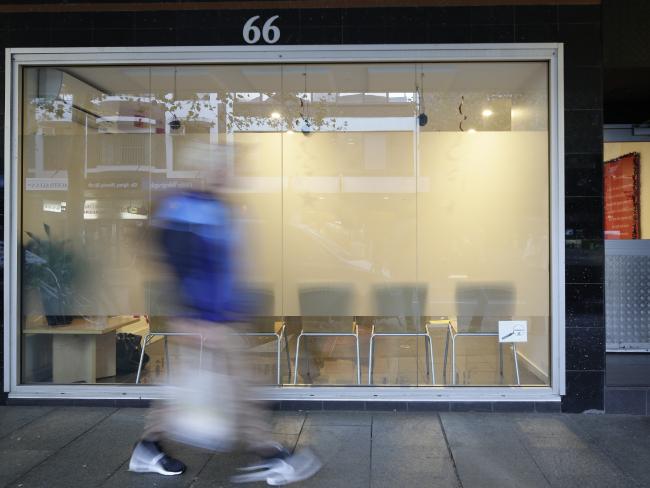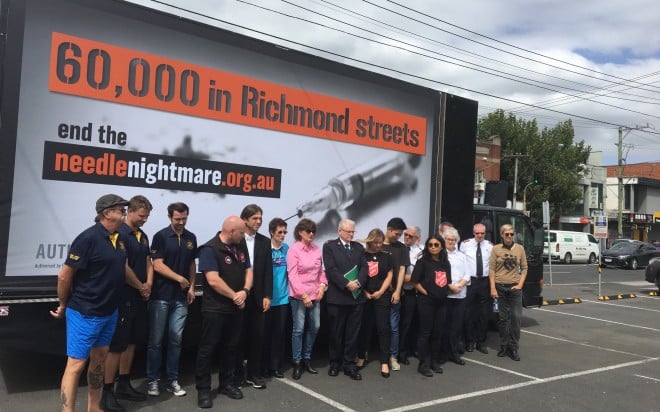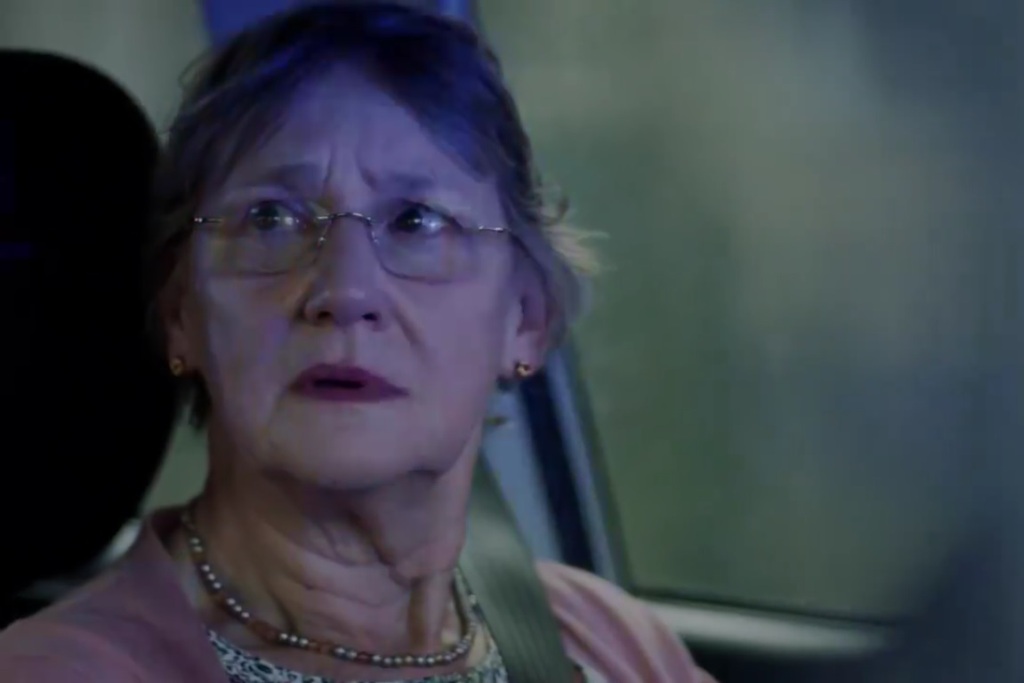Australia Is Lagging Behind On Safe Injecting Rooms And It’s Killing People
Why is politics still getting in the way of progress?

The tragic death of a 34-year-old Melbourne woman last year from a heroin overdose reignited a debate that has been raging in Victoria for more than a decade. The coronial report into the woman’s death, known only as Ms A, strongly recommended that a medically supervised injecting centre be opened in North Richmond, the epicentre of Victoria’s drug problem.
It was far from the first time that someone pushed for such a facility, but the socially progressive Daniel Andrews government remained steadfast in its refusal to even entertain the idea. It’s a move that could prove costly at next year’s election but, much more importantly, experts say it may lead to more lives being lost.
These facilities have attracted support nearly across the entire board — experts, researchers, doctors, locals and business owners. Why is politics still getting in the way of progress?
What Is A Safe Injecting Room?
A medically supervised injecting centre (MSIC), also known as a safe injecting room, is a clinic of sorts where people in possession of small quantities of illicit drugs are allowed to self-administer in sterile conditions.
The person must register before being provided with clean injecting equipment. After injecting, they’re then moved to a recovery area where trained counsellors provide outreach support and assistance with medical, housing and legal advice. A nurse or trained medical professional is present for this entire process, and will step in if an overdose occurs.
MSICs are placed in areas with an existing high level of drug use and overdoses. The centres work in tandem with more common schemes like clean syringe programs.
The first safe injecting room was launched in the Netherlands in the early ’70s. The concept became more prevalent in Europe in the 1990s. Following a recommendation by a royal commission, Australia’s first MSIC was opened in Sydney’s King’s Cross in 2001. The Sydney MSIC is now one of nearly 100 facilities in over 60 countries around the world.
Beginning its life as a trial program, the Sydney facility has about 150 visitors each day, and its staff have treated 6,500 overdoses, with no deaths at the site. The NSW state government has completed extensive studies into the effectiveness of the facility, finding that it’s reduced the number of overdoses in public spaces; reduced the number of ambulance call-outs in the area by 80 percent; provided over 9,500 referrals to health and social welfare services; reduced the number of needle and syringes collected in the area; and enjoyed “strong support” from locals and business owners.

The exterior of Sydney’s MSIC.
This facility has operated permanently since 2010, and while it has been open for more than 15 years with proven results, it is still the only one of its kind in Australia.
The Victorian Push
Advocates have been campaigning for a safe injecting site in Victoria for more than a decade, but have been unable to get enough political backing. The centres require legislation to be passed, allowing legal exemption at and around the site for individuals to be in possession of illicit drugs. While the debate has been brewing for years, the death of Ms A and coroner Jacqui Hawkins’ subsequent report brought further attention to the ongoing push for a MSIC in Melbourne.
Ms A was found in a Hungry Jacks bathroom in Richmond following a heroin overdose. She was taken to St Vincent’s Hospital but could not be resuscitated. Her death was one of many in the area. The City of Yarra saw 20 overdose deaths in 2015, with 14 of them happening in public spaces. This was out of a total of 172 overdose deaths across the state. More than 70,000 needles are distributed per month in North Richmond alone.
“We just don’t understand why it is that the government isn’t prepared to do this.”
Hawkins unequivocally called for a safe injecting facility to be installed in Richmond in her report on Ms A’s death, saying it would be a “critical step” in reducing the number of overdose deaths in the state, with an immediate impact. “There really isn’t anybody sensible [who] doesn’t acknowledge that supervised injecting facilities will save lives,” she wrote.
“You’ve got every medical organisation, every research organisation, every scientific community in Australia that’s come out and acknowledged the evidence is that they save lives.”

This seemed like the final thing to get Victoria on board with a safe injecting room. The state government had already been sent an open letter, co-signed by the Alcohol and Drug Foundation, Australian Medical Association, Yarra City Council and Ambulance Employees Australia. They had the support of locals in Richmond, research into Sydney’s success, and now the coroner’s report.
But they did nothing. In the days following Hawkins’ unflinching report, Premier Daniel Andrews quickly rejected the notion. “I have been very, very clear prior to the election and since. We have no plans to introduce a facility like that,” he said.
The prompt dismissal of a coroner’s recommendation is unusual, and little information has been revealed since about why exactly the Labor government is opposed to the concept. Greens MP Colleen Hartland said it was a huge missed opportunity. “It [would have] given them the political coverage to say, ‘it’s not us saying it, it’s the coroner’,” Hartland tells Junkee.
“But we just don’t understand why it is that the government isn’t prepared to do this. It’s life-saving. Sydney has had one for more than 15 years and it has proved its worth. We just don’t understand the government’s blockage on this.”
Minister for Mental Health Martin Foley offers little to help solve this mystery. “Drug addiction is complex — with no single solution having the ability to protect our community from its debilitating impacts,” Foley tells Junkee.
“The government has a number of harm minimisation responses and interventions to respond to legitimate health and community concerns. We have welcomed the Parliamentary Inquiry into Drug Law Reform, which has begun. [We] await the findings of this inquiry and anticipate that it will provide a valuable forum to examine these issues in greater depth and with appropriate time to consider the options.”
No one in the field is claiming that MSICs will solve the state’s drug problem — the coroner’s report explicitly said they were not the “silver bullet” — but when displayed alongside the state’s other harm minimisation policies centred on drug use, it would seem surely seem like a natural step?
A Divisive Policy
While the Victorian government trumpets itself as progressive and willing to make risky political decisions for the social good — which it has in some aspects — its steadfast refusal to even consider a safe injecting room stands in stark contrast to this.
There are many possible reasons for this refusal. The Victorian government has faced sustained calls from the media (mainly The Herald Sun) and the Opposition to deal with the state’s so-called “crime crisis”. This year’s budget saw $2 billion allocated to the police, a record for the state. A move to adopt a safe injecting room, often seen to be enabling crimes, would undoubtedly be used against the government in next year’s election.
It’s believed that many Labor politicians privately support the concept, but the government may not be willing to risk the fallout for the policy that would likely be shot down in the upper house, without the support of the Opposition.
Radio host Tom Elliott has summarised many of the arguments against the policy earlier this year. “While harmful drugs remain illegal, there’s no sound way society can tolerate a government-subsidised facility in which people are permitted to ingest them,” Elliott wrote in a Herald Sun opinion piece. “Facilities like the one suggested for North Richmond would force Victoria Police to ignore some of the important laws they’ve taken a serious oath to uphold.”
According to the National Drug Strategy Household Survey 2010, the majority of Australians actually support the concept of safe injecting rooms. The support for this scheme has steadily increased over the last decade according to the survey. While safe injecting rooms often are not welcomed in the suburbs they are designated, there’s no nimbyism in Richmond. The local council now backs a trial of the facility, while traders in the area have gradually changed their position and banded together to support the concept.
“When we accept that addiction is a health issue, we are able to consider more clearly what can and must be done to support heroin users and reduce their risk of death.”
While safe injecting rooms do require legislation providing the space legal exemption, studies into the Sydney facility have found that they did not increase drug use in the area and do not attract dealers to the area. And, according to the coroner, the introduction of such a facility is a public health issue aimed at helping vulnerable members of society.
“Heroin users face a daily battle against their compulsion to use and are at risk of death,” Hawkins said in her report. “They include some of the most marginalised to use and are at risk of death. They include some of the most marginalised and disadvantaged people in our society, who may suffer from physical and mental ill health, unemployment and homelessness, and come into contact with the criminal justice system as a result of their addiction.”
Hawkins says the debate hinges on whether drug addiction is considered a health issue. “When we accept that addiction is a health issue, we are able to consider more clearly what can and must be done to support heroin users and reduce their risk of death.”
What Now?
The Greens and Victorian Sex Party are leading the political push for a MSIC in the state, with Sex Party MP Fiona Patten introducing legislation to Parliament to establish a facility, but it has little chance of passing.
Greens MP Colleen Hartland has personally campaigned on the issue for more than a decade. Residing in Footscray during the worst of the drug problems in the area, she has been personally touched by the debate.
“I lived next door to the railway station, and people would score at the station and then come into my street to shoot up,” she tells Junkee. “I was terrified I would find someone dead on my verandah. For me the need for a supervised injecting room is something I’ve known for a long, long time.”
We're 16 years behind Sydney. #supervisedinjecting works there & it would work in Melb too https://t.co/It5wuxEGG8 #springst #RichmondMSIC
— Colleen Hartland MP (@ColleenHartland) February 17, 2017
The government’s stance on the issue may also prove costly in next year’s state election. Labor won the seat of Richmond in the last election by less than 800 votes, and with locals now in support of a safe injecting room, it could swing towards the Greens, who have full intention to make it the central campaign topic.
“The loss of a seat might be what gets them to change their minds,” Hartland says. “Richmond is very vulnerable to us, and we have every intention of turning this into a state election campaign next year… It isn’t always about legislation in Parliament, it’s about doing the work on the ground and using election campaigns to force government to do what they should. We won’t be giving that up.”
–
Feature image: Sydney MSIC.
–
Denham Sadler is a freelance writer based in Melbourne who has been published by The Saturday Paper, ABC and The Guardian. You can follow him on Twitter.
